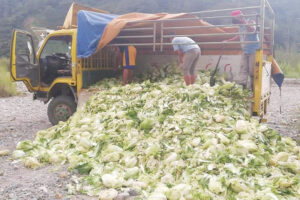Most of the gifts we received for Christmas were food and grocery items. And with today’s inflated prices, these gifts were very much appreciated. The fully stocked pantry minimized the number of market trips meantime. And, with food and groceries usually accounting for most of my family’s monthly budget, these gifts were a relief indeed. Nothing like eating for free.
And, luckily, we managed to minimize waste as well. We had only one case of spoilage during the holidays, the result of improper storage. Studies indicate most food waste occur at the consumer level. Many people buy more than they can consume, or perhaps stock up unnecessarily, but later end up disposing inventory due to spoilage or expiry.
It turns out, however, that waste is common not only in households but in farms as well. And these fall under the broader category of “food loss,” which refers to “any edible food that goes uneaten at any stage.” Food waste, on the other hand, normally refers to food already produced and marketed but discarded by retailers or consumers for one reason or the other.
So, if world hunger is the issue, then food loss may be more to blame than food waste itself. Food waste occurs mainly at the consumer level. But the problem of food loss is a bigger concern as it has greater impact on global food supply. Remember past incidents when local farmers ended up dumping their produce for lack of buyers? That is a perfect example of food loss.
A recent report from the UK by WWF-UK and Tesco highlights what they referred to as “hidden waste” in food production in the UK. The report elaborated on problems plaguing UK farms, and how issues with government policies and support as well as “poor system practices and policies” have resulted in high loss rates for farmers and food waste.
“In the UK food loss and waste (FLW) is reported as 9.5 million tons with 70% occurring in citizen homes. However, this figure excludes food loss and waste occurring on UK farms and therefore masks the true extent of food waste in the UK and its catastrophic environmental impacts. This study finds that in UK primary production alone an estimated 3.3 million tons of food is lost and wasted on farms in the UK each year,” reads the 2022 report titled, “Hidden Waste: The scale and impact of food waste in UK primary production.”
The report adds, “This suggests food loss and waste in the UK totals 12.8 million tons and that farm stage represents over 25% of food loss and waste (FLW) in UK, more than that occurring in manufacturing, retail and the hospitality and food sectors combined. This has a huge environmental impact, with FLW in UK primary production contributing 6 million tons of CO2eq., equivalent to approximately 10% of UK agricultural emissions and requiring an area of land half the size of Wales.”
But the report also notes that “previous research has demonstrated that much of the food loss occurring on farms is beyond the control of the farmers, driven by poor system practices and policies. Forty-eight percent of the food loss which occurs is pre-harvest, i.e., food left on fields, driven by decisions made post farmgate (e.g., standards and specifications) and an inflexible, broken food system. As such, farmers require support and system changes in order to support them in reducing loss rates and their impacts.”
The study also finds “that food lost on farms carries a value of £1.8 billion, value which could potentially be handed back to farmers and which previously studies suggest can lead to an average increase in profitability on farms of 20%. Farmers stand to see significant benefits from food loss reduction but a key step in this is measuring the loss occurring in order to better understand the drivers and ensure policy and practice changes which help reduce their impact on loss rates.”
Moreover, “2.9 million tons, or 6.9 billion meals’, worth of edible food is wasted on UK farms each year. Given the current cost-of-living crisis and a growing number of people in the UK facing food insecurity and poverty, this can no longer be ignored. Despite the potential of this wasted food to help combat food insecurity, and the role of such waste in driving environmental degradation, food waste on farms is not referenced in the UK’s Government Food Strategy, Nationally Determined Contributions, Net Zero strategy, or the plans for mandatory food waste reporting.”
Given the report’s findings, it is obvious that even UK farmers have reason to gripe, just like our local farmers. But we need to be able to gather reliable, credible, and comprehensive local data and statistics on food loss and food waste. Government and private sector data capture demand and production, but they should measure loss and waste as well.
In the UK, the recommendation is for action to support farmers “in beginning to measure, report, and reduce waste.” Among these actions is the “mandatory reporting of food surplus and waste.” The WWF-UK report also calls for “binding targets” to reduce food waste “from farm to fork” as well as subsidies for the “redistribution and reuse of food.”
Locally, suitable recommendations can be made but only if we have comprehensive research and data that include food loss and waste. Such can help policymakers make informed decisions on how to best improve local food production and supply. A balance between local production and calibrated importation will help stabilize supply and prices, and ensure that local demands are met. But how can we best quantify what we actually need if we do not know how much is actually lost and wasted in farms and on household tables?
Marvin Tort is a former managing editor of BusinessWorld, and a former chairman of the Philippine Press Council
